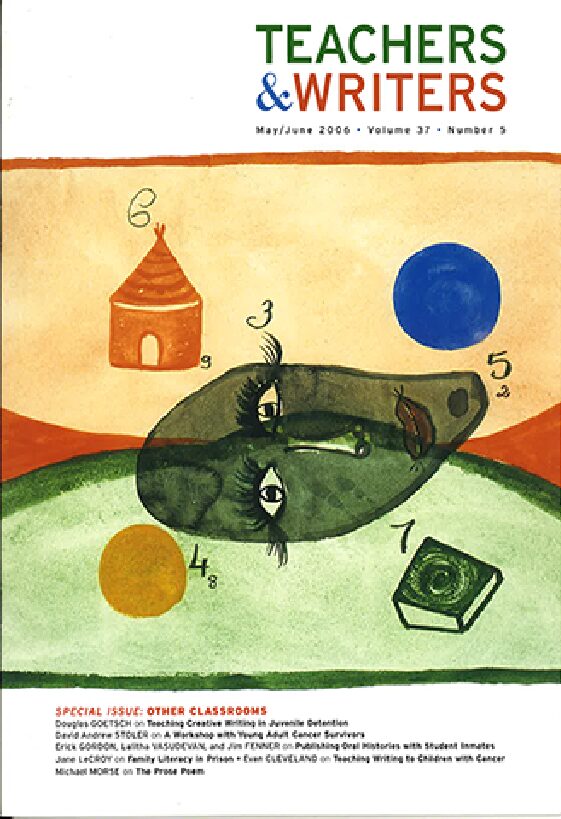FROM THE ARCHIVES: This article originally appeared in Teachers & Writers Magazine, May/June 2006, Volume 37, Issue 5.
We have all become familiar with the phrase “thinking outside the box,” used to express creative problem solving, but the expression “thinking outside the classroom” may deserve a place in our lexicon as well. Unique learning environments require unique teaching adaptations, as Judy Bauerle, a health educator in the University of Virginia (UVA) Psychiatry Department, discovered when she brought a family literacy program she’d been offering in a local health clinic into a prison environment. This new setting placed new and unanticipated demands on Bauerle’s program curriculum: making the program successful meant listening to the particular needs and desires of the inmates who participated in it and being willing to rethink program goals and methods to support the inmates’ definition of success.
A few years ago Bauerle began working with inmates at a Virginia state prison, running a series of workshops as part of Read To Me, a program that encourages and supports parents reading to their young children. The program, created by educator Susan Straub, is run as a series of workshops that explore and model the benefits of reading to babies and children. Participants are made aware that this simple activity has the power to stimulate children’s imagination, promote early literacy, and improve the potential for healthy parent-child relationships. Read To Me targets parents who may not have been read to when they were young, with the goal of introducing this activity as a source of pleasure for both the parents themselves and their children. Toward this end, Read To Me offers free books and an array of activities to program participants. The program has been used in a variety of settings, but at that point had never been brought into a prison.
It was while teaching the Read To Me program in a health clinic waiting room that Bauerle was inspired and encouraged to start working with inmates. Vivian Chasin, a retired psychiatric nurse who was co-leading a Brownie troop at a women’s state prison, happened to see the work Bauerle was doing and convinced her that the program had much to offer to inmates. Chasin had observed how the mothers she worked with maintained a deep concern for their children even though they were physically separated from them, and felt the Read To Me program could give these incarcerated parents another tool for connecting with their children. Though Bauerle had no experience teaching in such a setting, she put together a proposal and was able to convince both a men’s prison and a women’s prison to let her run the program on site. Financial support came from the Bama Works Foundation, funded by the Dave Matthews Band and administered by the Charlottesville-Albemarle Community Foundation, and also from a private donor. Other assistance came from Eliot Singer, a therapist with the UVA Under Fives Study Center, UVA undergraduate interns, and Janet van der Linde, a nurse and former pre-kindergarten teacher.
Bauerle found that working in prisons offered personal and professional challenges she hadn’t faced working in communities. These challenges could be as minor as not being able to bring a cell phone into the facility, or they could present obstacles that required her to rethink the way the program was ordinarily run.
For instance, limits on the materials she could bring into the prisons had a direct impact on the inmates’ ability to make books, a key activity of the Read To Me program and one which generally requires a variety of supplies. Bauerle wasn’t allowed to bring in scissors (the prison supplied their own) or “too many” stickers, or personal pictures; and had to find substitutes the rules would allow.
The prison atmosphere itself was also daunting at first. Most Read To Me programs are run in community spaces: cheery, friendly places. The prison rooms Bauerle worked in were plain and mostly undecorated. And though the program usually pro- vides snacks for participants, that was also not allowed in the prison setting. Bauerle was worried that this physical reality might put a damper on the program, but says the workshops were intimate and moving, despite their location. “What takes place during the sessions,” she says, “clearly transcends the space.”
Bauerle says she prepared for working in the prison system by trying to keep an open mind, and letting go of her expectations so that she could see the opportunities that presented themselves in this unique situation. One such opportunity became clear right away. Bauerle hadn’t predicted the advantages a prison setting would provide to consistent program attendance. Because the families that Read To Me targets often consist of single parents, teen moms, and parents who work multiple jobs, a group whose time is already heavily taxed, one of the biggest challenges program educators usually face is achieving regular workshop attendance. Prison turns out to be one place where attendance is not a problem.
As the program adjusted to this new setting, Bauerle says her thinking about the main objectives of the program evolved. “I’ve always seen Read To Me as a relationship-building program, and my goal in this setting was to focus on that aspect of the program,” she says, “helping parents and kids to better understand each other while at the same time promoting literacy and love of books.” In this, Bauerle says she thought of herself more as a facilitator than as a teacher, initiating and navigating conversations, and inviting participants to share their experiences, thoughts, and questions. “I wanted to help participants step out of their own perspectives in order to see the world through Thinking Outside the Box their children’s eyes.” Illuminating this contrast, through reading and talking about children’s books, gave the participants a way to strengthen their understanding of their own children.
Again and again, Bauerle says, program participants told her how they found their experience in the workshops transformative. One man she worked with was very focused on making a book for his child. After the session was over, he took the book and materials to continue working on it outside of the designated period. Other inmates, who were not familiar with the program, started taunting him, accusing him of playing with children’s toys. The man explained that he was making a book for his child and elaborated on why that was important to him. After that, the inmates’ response to his work became positive and cooperative, and some even joined in the endeavor; one fellow inmate printed text for the book, another made drawings, and others contributed their talents as well. The resulting book, beloved by the man’s child, was a sophisticated collaboration in which all who participated took pride.
Another participant told Bauerle how his young daughter would never talk to him on her visits to the prison. All his attempts to engage the child had been unsuccessful. Finally, one visit, the man brought a children’s book he’d been given by Read To Me and simply looked through it when his daughter was present. That act worked like an invitation she could accept; she was interested in the book and went over to him and asked about it. He read the book to her and they both enjoyed sharing the experience. Interactions between the two became much easier, and at every visit after that the girl requested that her father read to her.
One participant at the women’s prison said she could not get her four-year-old daughter to say anything to her during their phone calls. The woman told Bauerle she thought it was because the child was ashamed that her mother was in prison. Bauerle pointed out that to feel shame about that would be out of the emotional range of what a four-year-old might experience and that there was probably a different reason why communication with the child was so difficult. The woman began to cry, and for the first time admitted that she herself was ashamed. “Articulating that allowed her to put her own shame aside so that she could communicate with her child,” says Bauerle. The program helped out further by providing books that were sent home to the daughter, giving mother and child something positive to talk about.
The books provided by Read To Me proved to be an especially important component of the program. An inmate who said he had had no contact with his family for two years finally got a response and resumed communication again when he sent home books for his three children. Another participant relayed how his children loved the books he sent so much that they were sleeping with them. “The participants were surprised by how much the books were welcomed by their children and thrilled by the impact the program had on their lives,” says Bauerle. Through word-of-mouth the program is now one of the most popular offered in the prisons.
Teaching Read To Me in the prisons brought unexpected gifts to both participants and providers, says Bauerle. She is moved by the deep gratitude inmates express to her at having their role as parents recognized and valued, and says she continues to be impressed by the participants’ creativity, skill, and enthusiasm, how closely they pay attention and how generously they contribute to the workshops. Indeed, two inmates at a men’s prison who were part of the program are now running it themselves, and plan to continue offering it after they are released. Prison administrators, as well, have been very supportive of the Read To Me program and have expressed their appreciation for the ways it has helped the incarcerated parents. Bauerle says she herself finds the work especially interesting because it has afforded her the opportunity to learn about a population of which she had no previous firsthand knowledge. Though she expected it might be frightening to work in a prison, she found this was not true. “People are people,” she says, “facing challenges and having epiphanies, experiencing similar needs and wants, no matter how diverse in their personal history.” In the end, Bauerle says she found the drawbacks of the prison setting were more than compensated for by the eagerness with which the inmates embraced the program. “Though the room was stark,” she says, “the spirit evolved.”
© For more information, visit www.readtomeproject.org.
Jane LeCroy works as a poetry teacher in New York City schools through Teachers & Writers, and also teaches at a home school collective, and as an adjunct professor at Eugene Lang College. She is a singer/poet who records, performs regularly and tours with her main project, the avant-garde TRANSMITTING. You can find out more about her and her work at www.JaneLeCroy.com


